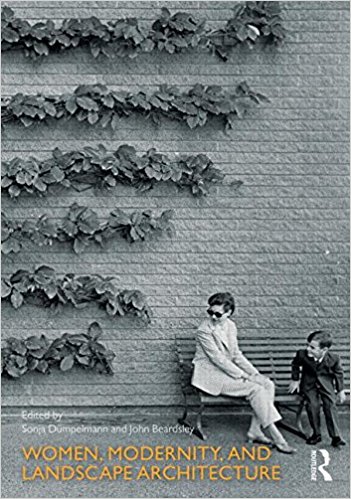Sonja Dümpelmann and John Beardsley
Routledge, 2015

Dümpelmann and Beardsley’s historiographic introduction provides a contextual overview of how landscape modernism emerged as a global transnational project through a strongly focused demonstration of women as integrated participants and influential leaders. The editors’ approach provides a broad framework outlining the women’s educational desires and experiences, design and planning practices, writing and teaching across the profession of landscape architecture as well as across national and professional boundaries. However, the book does not mention Asia at all. This may be a limitation of the conference participation that sparked the book or the ease of attracting western-language authors. The absence of Asian women leaves a hole in this record of women, landscape architecture, and the process of modernization.
Women did not “happen into” landscape architecture practices in the early 1900s; there were too many obstacles for them to easily pursue professional careers. Unlike texts focused on male practitioners, these essays disclose the women’s personal stories as they relate to the pursuit of their careers. And rather than using an encyclopedic approach of biographical sketches as in Charles Birnbaum and Robin Karson’s Pioneers of American Landscape Design (2000), Women, Modernity, and Landscape Architecture uses the women’s stories to illustrate their experiences in the modernization of landscape architectural practices. The stories relate the challenges middle-income women faced in obtaining professional educations commensurate with their male counterparts and in finding or creating their roles in landscape planning and design for a modernizing world. The authors relate how women’s personal and professional partnerships negotiated and challenged societal expectations of middle- and upper-income women as women were fighting for political and professional recognition. This was long before the second wave of feminism—characterized by Betty Friedan (The Feminine Mystique [1963]), Simone de Beauvoir (The Second Sex [1949]) and Carol Hanisch (“The Personal is Political” [1970])—broadly challenged preconceived gender roles and biases. The essays reveal the social and cultural expectations that stymied many middle-class women from actively participating in the professions, and they testify to the necessary sense of desire and perseverance required for women to join the professional ranks before the 1960s.
Chronologically ordered, the essays provide a timeline documenting a transitional process from traditional practices to a modernist professional agenda. The collection of essays can be read as a guide to what constituted a necessary modern education: studies of planting, plant sciences, and design theory; practical experience; and intentional travel to see and analyze historic and developing spatial practices in landscape design as well as to build broad practical exposure and professional connections. The essays demonstrate the roles women filled as landscape architects shaped new housing estates, urban neighborhoods, industrial towns, and campuses. The authors reveal how women successfully incorporated modern jobs, industrial processes, transportation, and recreational needs into designed places in rapidly changing regions across the globe. Women addressed challenges to scenic landscape preservation and large-scale land planning, and they helped shape urban and regional parks, industrial and civic landscapes, and the urban schemes of expanding cities and new towns.
Professional garden design, a primary area of landscape architectural practice in the early 1900s, required a strong knowledge of horticultural practices and plant sciences. Denied access to educational opportunities in their home countries or regions, stories of Ester Claesson and Ruth Brandberg (Sweden) relate how women often had to relocate to access tutors, internship and apprenticeship positions, and educational institutions that would accept female students. Catherine Nolin’s story of Ruth Brandberg moved from small-scale domestic planting and garden design to bringing landscape design—with an emphasis on horticulture and plant science —to larger homes, housing estates, parks, towns, and industrial landscapes, and then to scenic preservation. Dümpelmann’s tales of Herta Hammerbacher (Germany), Sylvia Crowe (Britain), and Maria Teresa Papagliolo (Italy) explores the transition from traditional design and planting to practices that addressed modern design and planning needs. Alla Vronskaya reveals the influential work of Militsa Prokhorava and Liubov’ Zalesskaia on urbanist Soviet landscapes that functionally organized spaces and produced picturesque landscape spectacles. Ulrike Krippner and Iris Meder remind us that World War II shattered the promising careers of women as well; Austrians Anna Plischke and Helene Wolf exemplified the Wohngarten style of the 1920s and 1930s until they were persecuted and exiled as Jews. Bernadette Blanchon uses the stories of three French women to bring attention to the value of everyday landscapes (Ingrid Bourne), political engagement through landscape development (Isabelle Auricoste), and large-scale land planning strategies (Marguerite Mercier). Jeremy Foster relates the landscape culture seen in a modern South African mining town through the work and story of Joane Pim.
Thaïsa Way reminds us of the constellation of American women who successfully argued for the inclusion of landscape and plant ecology in design. Ruth Shellhorn’s story by Kelly Comras includes the making of Disneyland and shopping malls as landscape experiences. Stories of Rosa Gena Kliass (Brazil) and Cornelia Hahn Oberlander (Canada) relate later professional development and practices that fully embrace and advance modern approaches to the design of the built environment. Through site-specific design and master planning, policy and planning regulations, and their teaching and writings, these women and others not identified have made significant contributions to the development of landscapes around the globe and to the continued relevance of landscape architecture.
Women, Modernity, and Landscape Architecture can be used as a general textbook to illustrate the wide scope of landscape architecture practices during an intense period of global modernization. Authors of the next edition in this timeline must be challenged to include Asian perspectives as well. That the book uses the work of women is a welcome addition to texts on modernity and landscape architecture. We will know that women have fully “arrived” in the profession when we no longer need to separate our stories along gender lines.
How to Cite this Article: Clement, Terry. Review of Women, Modernity, and Landscape Architecture, by Sonja Dumpelmann and John Beardsley. JAE Online. February 16, 2018. https://jaeonline.org/issue-article/women-modernity-and-landscape-architecture/.






